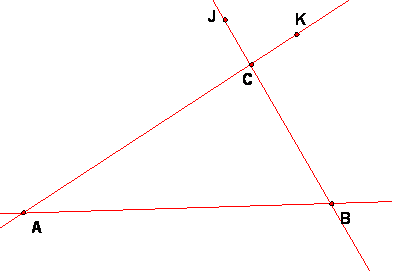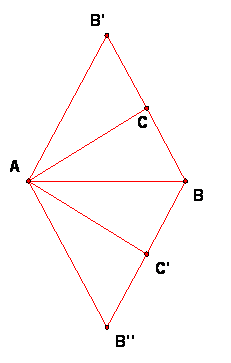
From Final Exam 2001
Problem C2: Construction Problem for Isometries
Given points A and B, let S = A60 = rotation by 60 degrees with center A and let T be B120 = rotation by 120 degrees with center B. Tell what is U = ST and construct (with straightedge and compass) the geometric data needed to define this transformation directly. (Geometric data means centers, mirror or invariant lines, vectors, etc.)
From Brown, 2.4, we see that this composition U is a rotation by 60+120 = 180 degrees, i.e., a half turn C180. What is needed to complete the answer is to construct the point C that is the center of this rotation.
The method explained in Brown is to write S and T as the composition of two lines each, so T = Rm2 Rm1 and S = Rm4 Rm3. Then U = Rm4 Rm3 Rm2 Rm1. The trick here is to make m3 and m2 be the same line, so that the product of the middle two reflections is I, the identity, and U = Rm4 I Rm1 = Rm4 Rm1. IMPORTANT: It is critical to get the order of composition right. In this case of ST is it first B rotation, then A.
To construct m1 and m2, we let m1 = BJ and m2 = BA, with signed angle JBA = (1/2)120 = 60. Then m3 = line AB and m4 = line AK, with signed angle BAK = (1/2)60 = 30 degrees. These angles of 60 and 30 degrees can be constructed with straightedge and compass by constructing an equilateral triangle to get an angle of 60 degrees and bisecting this angle to get 30 degrees.

This triangle ABC has angle A = 30 degrees, angle B = 60 degrees and angle C = 90 degrees. The angle at C is what is expected, for the exterior angle at C should be 180/2 = 90.
This is the answer to the problem, but there is more that we can see in this figure.
To check that this answer makes sense and is correct,
let's check the value of U at some points. Since we know U is a rotation, the
image of two points is enough to
One can use the same method to compute the inverse of U = B-120 A-60 = B240 A300
If you carry this out, you will construct the same triangle. In this case m1 = line AK, m2 = m3 = line AB and m4 = line BJ. As should be the case for the inverse of a rotation, the center is the same point C and the angle is -180, which is the same as rotation by +180.
As an exercise, find the center of the rotation V = TS. It should turn out to be reflection C' of C in AB. The angle of rotation is still 180 degrees since the sum of the angles is not changed when the order of composition is change.
Find the center of the rotation
What rotations centered at B and C can be composed
to give a rotation with center A?
Reflect B across AC to define B'. Reflect B' and C across AB to get B'' and C'. Then check these facts.
